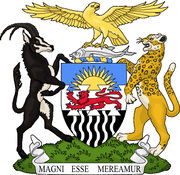Rhodesialund Armed Forces
(In progress) The Armed Forces of Rhodesialund have gained a reputation of being very mobile in the East Pacific, especially after Operation Buffer. Military service is considered mandatory at the age of 18 and all citizens must serve for at least 2 years. Then they can choose to continue serving or enter a citizen's life. After a citizen finishes his two years requirement, he is free to live their lives unfettered. Should a war ever break out, military recruiters will recruit veterans to serve again, but only with the citizen's consent.
Contents
Command
Command of the Rhodesialund Armed Forces are split into four different branches. However, each and every branch work together closely on matters.
Army
The Army is more relegated to a "Self-Defensive" land force but is capable of fighting overseas if need be to reinforce strategic locations taken by the Marines.
Marines
The Marines are the primary land force in which the Rhodelundians take pride in. It is a very mobile force being anywhere, anytime, in a short notice. Officially, the Marines comprise a larger infantry force than the Army itself.
The Rhodesialund Marines currently service the Rhode Heavy Works M1A1 Main Battle Tank. Other vehicles in service include the LAV-25, Striker, and the Amphibious Assault Vehicle.
Marine Aviation
To promote further capabilities, the Marines have an Aviation component. However they only use rotary-wing aircraft. In service are the AH-1Z Wildcat, and the UH-1Y Bane.
Also used are the RAe Systems CH-47D Kru. The "Kru" is an updated version of the Chinook, with self-folding blades for easier stowage, upgraded electronics done by CyberDyne Systems, and a upgraded air-frame using less parts for less maintenance and checkup efforts.
The Navy is seen as the first line of defense against any threats overseas. While not as large as others, it is capable of putting a hurt on their enemies thanks to the nation's strategic location next to international shipping routes.
Fleet Air Arm
The Fleet Air Arm is a branch of the Navy responsible for operation of naval aircraft. It currently operates the RAe Systems Skua II, RP-3C Albatross, and the SH-3H Gull
Fleets
Rhodesialund currently sails two fleets: . Details of such fleets are shown below:
| 1st Fleet: | 2nd Fleet: |
|
|
Submarines and frigates not part of the fleet operate in packs of two, patrolling the seas near Rhodesialund.
Air Force
The Air Force is tasked with taking care of logistical airlift, air superiority, and tactical strikes. It currently services the F-16C "Copperhead", a name picked for when the planes were originally equipped with the gold-tinted canopies. The Copperhead serves as the mainstay multi-role fighter of the Federal Republic of Rhodesialund, supplanted by the F-16D, a two-seater version. The Air Force is looking into options of upgrading the Copperheads further with conformal fuel tanks and more advanced avionics. The Copperhead is slowly replacing the F-4E "Spirit".
For logistical airlift, the Air Force relies on RC-17 "Petrel". It provides both strategic and tactical airlift while maintaining a "global" capability. The Rhodesialund Air Force faced trouble trying to decide a sole airlift plane that can readily transport the nation's MBTs and equipment without having to rely heavily on ships. The Il-76 was a close contender, but eventually lost out due to the lack of cargo space and maintenance costs, although it was cheaper than the "Petrel" to purchase. The winner replaced the aging fleet of C-133 Cargomasters.
The branch also operates locally produced RAe Systems TF-39 as trainers and seeks to export them.

